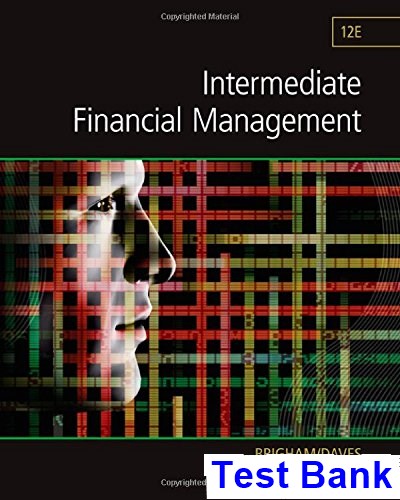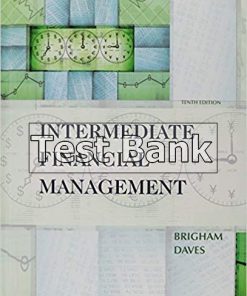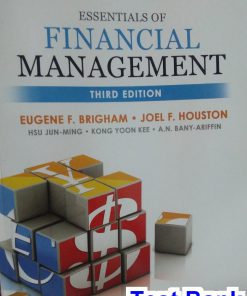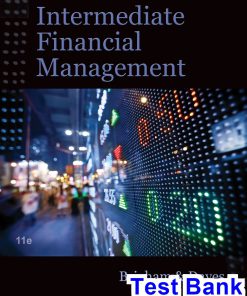Intermediate Financial Management 12th Edition Brigham Test Bank
$26.50$50.00 (-47%)
Intermediate Financial Management 12th Edition Brigham Test Bank.
You may also like
Intermediate Financial Management 12th Edition Brigham Test Bank

Product details:
- ISBN-10 : 1305720105
- ISBN-13 : 978-1305720107
- Author: Dr. Eugene F. Brigham
The only textbook written specifically for Intermediate or Advanced Corporate Finance courses, Brigham/Daves’ INTERMEDIATE FINANCIAL MANAGEMENT, 12E equips students with a solid understanding of both conceptual theories and practical financial skills. Offering a clear presentation, this comprehensive text from renowned author team Gene Brigham and Phillip Daves reinforces coverage from earlier corporate finance courses while providing new, progressive material to challenge even the most advanced learners. The authors use corporate valuation as a unifying theme to emphasize the theoretic groundwork for value maximization and the practical skills to analyze business decisions. The book’s reader-friendly approach incorporates actual business examples and integrated cases as well as Excel spreadsheet models to demonstrate how financial theory in practice leads to solid financial decisions.
Table contents:
- Part I: Fundamental Concepts of Corporate Finance
- Ch 1: An Overview of Financial Management and the Financial Environment
- Beginning-of-Chapter Questions
- 1-1: How to Use this Text
- Box: The Global Economic Crisis
- Box: Columbus Was Wrong-The World Is Flat! And Hot! And Crowded!
- 1-2: The Corporate Life Cycle
- 1-3: The Primary Objective of the Corporation: Value Maximization
- Box: Ethics for Individuals and Businesses
- Box: Corporate Scandals and Maximizing Stock Price
- 1-4: An Overview of the Capital Allocation Process
- 1-5: Financial Securities
- 1-6: The Cost of Money
- 1-7: The Global Economic Crisis
- Box: Global Economic Crisis- Anatomy of a Toxic Asset
- 1-8: The Big Picture
- 1-9: e-Resources
- Ch 1: Summary
- Ch 2: Risk and Return: Part I
- Beginning-of-Chapter Questions
- 2-1: Investment Returns and Risk
- Box: Intrinsic Value, Risk, and Return
- 2-2: Measuring Risk for Discrete Distributions
- 2-3: Risk in a Continuous Distribution
- 2-4: Using Historical Data to Estimate Risk
- Box: What does Risk Really Mean?
- Box: The Historic Trade-Off between Risk and Return
- 2-5: Risk in a Portfolio Context
- 2-6: The Relevant Risk of a Stock: The Capital Asset Pricing Model (CAPM)
- Box: The Benefits of Diversifying Overseas
- 2-7: The Relationship between Risk and Return in the Capital Asset Pricing Model
- 2-8: The Efficient Markets Hypothesis
- Box: Another Kind of Risk: The Bernie Madoff Story
- 2-9: The Fama-French Three-Factor Model
- 2-10: Behavioral Finance
- 2-11: The CAPM and Market Efficiency: Implications for Corporate Managers and Investors
- Summary
- Ch 3: Risk and Return: Part II
- Beginning-of-Chapter Questions
- Box: Intrinsic Value, Risk, and Return
- 3-1: Efficient Portfolios
- 3-2: Choosing the Optimal Portfolio
- 3-3: The Basic Assumptions of the Capital Asset Pricing Model
- 3-4: The Capital Market Line and the Security Market Line
- Box: Skill or Luck?
- 3-5: Calculating Beta Coefficients
- 3-6: Empirical Tests of the CAPM
- 3-7: Arbitrage Pricing Theory
- Summary
- Ch 4: Bond Valuation
- Beginning-of-Chapter Questions
- Box: Intrinsic Value and the Cost of Debt
- 4-1: Who Issues Bonds?
- Box: The Global Economic Crisis- Betting with or Against the U.S. Government: The Case of Treasury B
- 4-2: Key Characteristics of Bonds
- 4-3: Bond Valuation
- 4-4: Changes in Bond Values Over Time
- Box: Drinking Your Coupons
- 4-5: Bonds with Semiannual Coupons
- 4-6: Bond Yields
- 4-7: The Pre-Tax Cost of Debt: Determinants of Market Interest Rates
- 4-8: The Real Risk-Free Rate of Interest, r*
- 4-9: The Inflation Premium (IP)
- 4-10: The Nominal, or Quoted, Risk-Free Rate of Interest, rRF
- 4-11: The Default Risk Premium (DRP)
- Box: The Global Economic Crisis- Insuring with Credit Default Swaps: Let the Buyer Beware!
- Box: The Global Economic Crisis- U.S. Treasury Bonds Downgraded!
- Box: The Few, the Proud, the … AAA-Rated Companies!
- Box: The Global Economic Crisis- Fear and Rationality
- 4-12: The Liquidity Premium (LP)
- 4-13: The Maturity Risk Premium (MRP)
- 4-14: The Term Structure of Interest Rates
- 4-15: Financing with Junk Bonds
- 4-16: Bankruptcy and Reorganization
- Summary
- Ch 5: Financial Options
- Beginning-of-Chapter Questions
- Box: The Intrinsic Value of Stock Options
- 5-1: Overview of Financial Options
- Box: Financial Reporting for Employee Stock Options
- 5-2: The Single-Period Binomial Option Pricing Approach
- 5-3: The Single-Period Binomial Option Pricing Formula
- 5-4: The Multi-Period Binomial Option Pricing Model
- 5-5: The Black-Scholes Option Pricing Model (OPM)
- Box: Taxes and Stock Options
- 5-6: The Valuation of Put Options
- 5-7: Applications of Option Pricing in Corporate Finance
- Summary
- Ch 6: Accounting for Financial Management
- Beginning-of-Chapter Questions
- Box: Intrinsic Value, Free Cash Flow, and Financial Statements
- 6-1: Financial Statements and Reports
- 6-2: The Balance Sheet
- Box: The Global Economic Crisis- Let’s Play Hide-and-Seek!
- 6-3: The Income Statement
- 6-4: Statement of Stockholders’ Equity
- Box: Financial Analysis on the Web
- 6-5: Statement of Cash Flows
- Box: Filling in the GAAP
- 6-6: Net Cash Flow
- 6-7: Free Cash Flow: The Cash Flow Available for Distribution to Investors
- Box: Sarbanes-Oxley and Financial Fraud
- 6-8: Performance Evaluation
- 6-9: The Federal Income Tax System
- Box: When It Comes to Taxes, History Repeats and Repeals Itself!
- Summary
- Ch 7: Analysis of Financial Statements
- Beginning-of-Chapter Questions
- Box: Intrinsic Value and Analysis of Financial Statements
- 7-1: Financial Analysis
- 7-2: Liquidity Ratios
- 7-3: Asset Management Ratios
- Box: The Global Economic Crisis- The Price is Right! (Or Wrong!)
- 7-4: Debt Management Ratios
- 7-5: Profitability Ratios
- Box: The World Might Be Flat, But Global Accounting Is Bumpy! The Case of IFRS versus FASB
- 7-6: Market Value Ratios
- 7-7: Trend Analysis, Common Size Analysis, and Percentage Change Analysis
- 7-8: Tying the Ratios Together: The DuPont Equation
- 7-9: Comparative Ratios and Benchmarking
- 7-10: Uses and Limitations of Ratio Analysis
- Box: Ratio Analysis on the Web
- 7-11: Looking Beyond the Numbers
- Summary
- Part II: Corporate Valuation
- Ch 8: Basic Stock Valuation
- Beginning-of-Chapter Questions
- Box: Corporate Valuation and Stock Prices
- 8-1: Legal Rights and Privileges of Common Stockholders
- 8-2: Types of Common Stock
- 8-3: Stock Market Reporting
- 8-4: Valuing Common Stocks—Introducing the Free Cash Flow (FCF) Valuation Model
- 8-5: The Constant Growth Model: Valuation When Expected Free Cash Flow Grows at a Constant Rate
- 8-6: The Multi-Stage Model: Valuation When Expected Short-Term Free Cash Flow Grows at a Nonconstant
- 8-7: Application of the FCF Valuation Model to MicroDrive
- 8-8: Do Stock Values Reflect Long-Term or Short-Term Cash Flows?
- 8-9: Using the Free Cash Flow Valuation Model to Identify Value Drivers
- 8-10: Why Are Stock Prices so Volatile?
- 8-11: Valuing Common Stocks with the Dividend Growth Model
- 8-12: Market Multiple Analysis
- 8-13: Preferred Stock
- Summary
- Ch 9: Corporate Valuation and Financial Planning
- Beginning-of-Chapter Questions
- Box: Corporate Valuation and Financial Planning
- 9-1: Overview of Financial Planning
- 9-2: Financial Planning at MicroDrive Inc.
- 9-3: Forecasting Operations
- 9-4: Projecting MicroDrive’s Financial Statements
- 9-5: Analysis and Revision of the Preliminary Plan
- 9-6: Additional Funds Needed (AFN) Equation Method
- 9-7: Forecasting When the Ratios Change
- Summary
- Ch 10: Corporate Governance
- Beginning-of-Chapter Questions
- Box: Corporate Governance and Corporate Valuation
- 10-1: Agency Conflicts
- 10-2: Corporate Governance
- Box: The Global Economic Crisis- Would the U.S. Government Be an Effective Board Director?
- Box: The Dodd-Frank Act and “Say on Pay”
- Box: The Sarbanes-Oxley Act of 2002 and Corporate Governance
- Box: International Corporate Governance
- 10-3: Employee Stock Ownership Plans (ESOPs)
- Summary
- Ch 11: Determining the Cost of Capital
- Beginning-of-Chapter Questions
- Box: Corporate Valuation and the Cost of Capital
- 11-1: The Weighted Average Cost of Capital
- 11-2: Choosing Weights for the Weighted Average Cost of Capital
- 11-3: After-Tax Cost of Debt: rd(1 – T) and rstd(1 – T)
- Box: How Effective is the Effective Corporate Tax Rate?
- 11-4: Cost of Preferred Stock, rps
- 11-5: Cost of Common Stock: The Market Risk Premium, RPM
- 11-6: Using the CAPM to Estimate the Cost of Common Stock, rs
- 11-7: Dividend-Yield-Plus-Growth-Rate, or Discounted Cash Flow (DCF), Approach
- 11-8: The Weighted Average Cost of Capital (WACC)
- Box: Global Variations in the Cost of Capital
- 11-9: Adjusting the Cost of Equity for Flotation Costs
- 11-10: Privately Owned Firms and Small Businesses
- 11-11: Managerial Issues and the Cost of Capital
- Summary
- Part III: Project Valuation
- Ch 12: Capital Budgeting: Decision Criteria
- Beginning-of-Chapter Questions
- Box: Corporate Valuation and Capital Budgeting
- 12-1: An Overview of Capital Budgeting
- 12-2: The First Step in Project Analysis
- 12-3: Net Present Value (NPV)
- 12-4: Internal Rate of Return (IRR)
- 12-5: Modified Internal Rate of Return (MIRR)
- 12-6: Profitability Index (PI)
- 12-7: Payback Period
- 12-8: How to Use the Different Capital Budgeting Methods
- 12-9: Other Issues in Capital Budgeting
- Summary
- Ch 13: Capital Budgeting: Estimating Cash Flows and Analyzing Risk
- Beginning-of-Chapter Questions
- Box: Project Valuation, Cash Flows, and Risk Analysis
- 13-1: Identifying Relevant Cash Flows
- 13-2: Analysis of an Expansion Project
- Box: Mistakes in Cash Flow Estimation Can Kill Innovation
- 13-3: Risk Analysis in Capital Budgeting7
- 13-4: Measuring Stand-Alone Risk
- 13-5: Sensitivity Analysis
- 13-6: Scenario Analysis
- 13-7: Monte Carlo Simulation
- 13-8: Project Risk Conclusions
- 13-9: Replacement Analysis
- 13-10: Real Options
- 13-11: Phased Decisions and Decision Trees
- Summary
- Appendix 13A: Tax Depreciation
- Ch 14: Real Options
- Beginning-of-Chapter Questions
- 14-1: Valuing Real Options
- 14-2: The Investment Timing Option: An Illustration
- 14-3: The Growth Option: An Illustration
- 14-4: Concluding Thoughts on Real Options
- Summary
- Part IV: Strategic Financing Decisions
- Ch 15: Distributions to Shareholders: Dividends and Repurchases
- Beginning-of-Chapter Questions
- Box: Uses of Free Cash Flow: Distributions to Shareholders
- 15-1: An Overview of Cash Distributions
- 15-2: Procedures for Cash Distributions
- 15-3: Cash Distributions and Firm Value
- 15-4: Clientele Effect
- 15-5: Information Content, or Signaling, Hypothesis
- 15-6: Implications for Dividend Stability
- Box: Will Dividends Ever Be the Same?
- 15-7: Setting the Target Distribution Level: The Residual Distribution Model
- 15-8: The Residual Distribution Model in Practice
- 15-9: A Tale of Two Cash Distributions: Dividends versus Stock Repurchases
- 15-10: The Pros and Cons of Dividends and Repurchases
- Box: Dividend Yields Around the World
- 15-11: Other Factors Influencing Distributions
- 15-12: Summarizing the Distribution Policy Decision
- 15-13: Stock Splits and Stock Dividends
- Box: The Global Economic Crisis- Talk about a Split Personality!
- 15-14: Dividend Reinvestment Plans
- Summary
- Ch 16: Capital Structure Decisions
- Beginning-of-Chapter Questions
- Box: Corporate Valuation and Capital Structure
- 16-1: An Overview of Capital Structure
- 16-2: Business Risk and Financial Risk
- 16-3: Capital Structure Theory
- Box: Yogi Berra on the MM Proposition
- 16-4: Capital Structure Evidence and Implications
- 16-5: Estimating the Optimal Capital Structure
- 16-6: Anatomy of a Recapitalization
- Box: The Global Economic Crisis- Deleveraging
- Summary
- Ch 17: Dynamic Capital Structures and Corporate Valuation
- Beginning-of-Chapter Questions
- Box: Corporate Valuation and Capital Structure Decisions
- 17-1: The Impact of Growth and Tax Shields on Value
- 17-2: The Modigliani and Miller Models and the Compressed Adjusted Present Value (APV) Model
- 17-3: Dynamic Capital Structures and the Adjusted Present Value (APV) Model
- 17-4: Risky Debt and Equity as an Option
- 17-5: Introducing Personal Taxes: The Miller Model
- 17-6: Capital Structure Theory: Arbitrage Proofs of the Modigliani-Miller Theorems
- Summary
- Part V: Tactical Financing Decisions
- Ch 18: Initial Public Offerings, Investment Banking, and Financial Restructuring
- Beginning-of-Chapter Questions
- 18-1: The Financial Life Cycle of a Start-up Company
- 18-2: The Decision to Go Public
- 18-3: The Process of Going Public: An Initial Public Offering
- 18-4: Equity Carve-Outs: A Special Type of IPO
- 18-5: Other Ways to Raise Funds in the Capital Markets
- Box: Where There’s Smoke There’s Fire
- 18-6: Investment Banking Activities and Their Role in the Global Economic Crisis
- Box: What was the Role of Investment Banks?
- 18-7: The Decision to Go Private
- 18-8: Managing the Maturity Structure of Debt
- 18-9: Refunding Operations
- Box; TVA Ratchets Down Its Interest Expenses
- 18-10: Managing the Risk Structure of Debt with Project Financing
- Summary
- Ch 19: Lease Financing
- Beginning-of-Chapter Questions
- 19-1: Types of Leases
- 19-2: Tax Effects
- 19-3: Financial Statement Effects
- Off-Balance Sheet Financing: Is It Going to Disappear?
- 19-4: Evaluation by the Lessee
- 19-5: Evaluation by the Lessor
- 19-6: Other Issues in Lease Analysis
- Box: What You Don’t Know Can Hurt You!
- Box: Lease Securitization
- 19-7: Other Reasons for Leasing
- Summary
- Ch 20: Hybrid Financing: Preferred Stock, Warrants, and Convertibles
- Beginning-of-Chapter Questions
- 20-1: Preferred Stock
- Box: The Romance Had No Chemistry, but It Had a Lot of Preferred Stock!
- Box: Hybrids Aren’t Only for Corporations
- 20-2: Warrants
- 20-3: Convertible Securities
- 20-4: A Final Comparison of Warrants and Convertibles
- 20-5: Reporting Earnings When Warrants or Convertibles Are Outstanding
- Summary
- Part VI: Working Capital Management
- Ch 21: Supply Chains and Working Capital Management
- Beginning-of-Chapter Questions
- Box: Corporate Valuation and Working Capital Management
- 21-1: Overview of Working Capital Management
- 21-2: Using and Financing Operating Current Assets
- 21-3: The Cash Conversion Cycle
- Box: Some Firms Operate with Negative Working Capital!
- 21-4: The Cash Budget
- 21-5: Cash Management and the Target Cash Balance
- 21-6: Cash Management Techniques
- Box: Your Check Isn’t in the Mail
- 21-7: Inventory Management
- Box: Supply Chain Management
- 21-8: Receivables Management
- Box: Supply Chain Finance
- 21-9: Accruals and Accounts Payable (Trade Credit)
- Box: A Wag of the Finger or Tip of the Hat? The Colbert Report and Small Business Payment Terms
- 21-10: Managing Short-Term Investments
- 21-11: Short-Term Financing
- 21-12: Short-Term Bank Loans
- 21-13: Commercial Paper
- 21-14: Use of Security in Short-Term Financing
- Summary
- Ch 22: Providing and Obtaining Credit
- Beginning-of-Chapter Questions
- 22-1: Credit Policy
- 22-2: Setting the Credit Period and Standards
- 22-3: Setting the Collection Policy
- 22-4: Cash Discounts
- 22-5: Other Factors Influencing Credit Policy
- 22-6: The Payments Pattern Approach to Monitoring Receivables
- 22-7: Analyzing Proposed Changes in Credit Policy
- 22-8: Analyzing Proposed Changes in Credit Policy: Incremental Analysis
- 22-9: The Cost of Bank Loans
- 22-10: Choosing a Bank
- Summary
- Ch 23: Other Topics in Working Capital Management
- Beginning-of-Chapter Questions
- 23-1: The Concept of Zero Working Capital
- 23-2: Setting the Target Cash Balance
- 23-3: Inventory Control Systems
- 23-4: Accounting for Inventory
- 23-5: The Economic Ordering Quantity (EOQ) Model
- 23-6: EOQ Model Extensions
- Summary
- Part VII: Special Topics
- Ch 24: Enterprise Risk Management
- Beginning-of-Chapter Questions
- Box: Corporate Valuation and Risk Management
- 24-1: Reasons to Manage Risk
- 24-2: An Overview of Enterprise Risk Management
- 24-3: A Framework for Enterprise Risk Management
- 24-4: Categories of Risk Events
- 24-5: Foreign Exchange (FX) Risk
- 24-6: Commodity Price Risk
- 24-7: Interest Rate Risk
- Box: The Game of Truth or LIBOR
- 24-8: Project Selection Risks
- 24-9: Managing Credit Risks
- 24-10: Risk and Human Safety
- Summary
- Ch 25: Bankruptcy, Reorganization, and Liquidation
- Beginning-of-Chapter Questions
- 25-1: Financial Distress and Its Consequences
- 25-2: Issues Facing a Firm in Financial Distress
- 25-3: Settlements without Going through Formal Bankruptcy
- 25-4: Federal Bankruptcy Law
- 25-5: Reorganization in Bankruptcy
- 25-6: Liquidation in Bankruptcy
- Box: A Nation of Defaulters?
- 25-7: Anatomy of a Bankruptcy: Transforming the GM Corporation into the GM Company
- 25-8: Other Motivations for Bankruptcy
- 25-9: Some Criticisms of Bankruptcy Laws
- Summary
- Ch 26: Mergers and Corporate Control
- Beginning-of-Chapter Questions
- 26-1: Rationale for Mergers
- 26-2: Types of Mergers
- 26-3: Level of Merger Activity
- 26-4: Hostile versus Friendly Takeovers
- 26-5: Merger Regulation
- 26-6: Overview of Merger Analysis
- 26-7: The Free Cash Flow to Equity (FCFE) Approach
- 26-8: Illustration of the Three Valuation Approaches for a Constant Capital Structure
- 26-9: Setting the Bid Price
- 26-10: Analysis When There Is a Permanent Change in Capital Structure
- 26-11: Taxes and the Structure of the Takeover Bid
- Box: Tempest in a Teapot?
- 26-12: Financial Reporting for Mergers
- 26-13: Analysis for a “True Consolidation”
- 26-14: The Role of Investment Bankers
- 26-15: Who Wins: The Empirical Evidence
- Box: Merger Mistakes
- 26-16: Corporate Alliances
- 26-17: Divestitures
- 26-18: Holding Companies
- Summary
- Ch 27: Multinational Financial Management
- Beginning-of-Chapter Questions
- Box: Corporate Valuation in a Global Context
- 27-1: Multinational, or Global, Corporations
- 27-2: Multinational versus Domestic Financial Management
- 27-3: Exchange Rates
- 27-4: Exchange Rates and International Trade
- 27-5: The International Monetary System and Exchange Rate Policies
- 27-6: Trading in Foreign Exchange
- 27-7: Interest Rate Parity
- 27-8: Purchasing Power Parity
- Box: Hungry for a Big Mac? Go To Ukraine!
- 27-9: Inflation, Interest Rates, and Exchange Rates
- 27-10: International Money and Capital Markets
- Box: Greasing the Wheels of International Business
- Box: Stock Market Indices Around the World
- 27-11: Multinational Capital Budgeting
- Box: Consumer Finance in China
- Box: Double Irish with a Dutch Twist
- 27-12: International Capital Structures
- 27-13: Multinational Working Capital Management
- Summary
- Appendixes
- Appendix A: Values of the Areas under the Standard Normal Distribution Function
- Appendix B: Answers to End-of-Chapter Problems
- Appendix C: Selected Equations
- Glossary
- Name Index
- Subject Index
People also search:
|
intermediate financial management 12th edition
|
what is intermediate cost class 12
is intermediate class 12
features of financial management class 12
what is meant by financial management class 12












